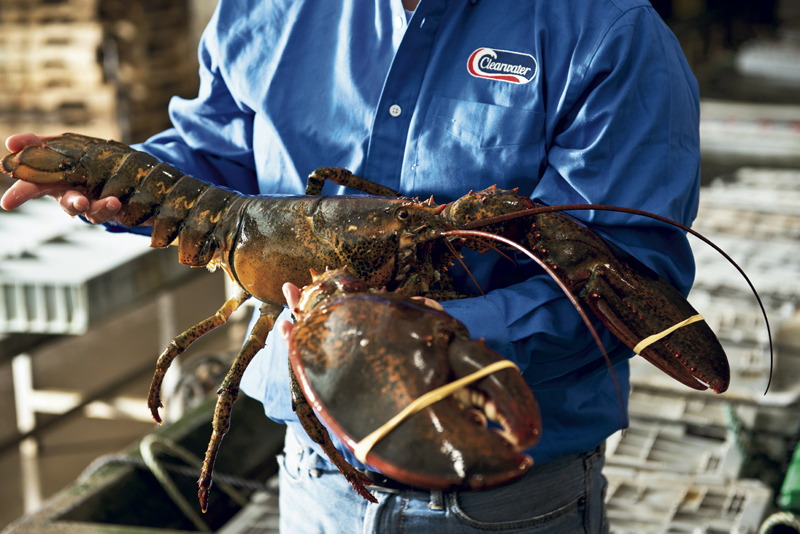Outpost of the Atlantic Maritimes thrives in Louisville
In a nondescript business park in South Louisville, among loading docks and plain-faced offices, a Nova Scotia company is busy handling a treasure among ocean seafood — live, hard-shelled lobster harvested from the cold Atlantic waters of Canada’s maritime provinces.
Clearwater Seafood, set up operations here when UPS established its air freight operations in 1999. The company built huge, custom holding tanks that replicate ocean conditions and unobserved, and unknown to most passing motorists, ship more than half a million pounds each year of the spiny creatures across North America.
When the doors swing open to unload the weekly tractor trailer delivering ten to twenty thousand pounds, the distinct salty smell of a northern harbor wharf comes rolling out. If you closed your eyes, you could picture seaweed covered pilings at low tide and gulls circling overhead to observe the action.
As the fork lift starts to unload large plastic crates marked with abbreviations of the port of origin and a number showing the minimum weight of each treasured crustacean inside — 1 1/2, 3, 6, 9. Clearwater Operations Manager Paul Valdez pulls open the clam shell top of a crate marked “9” and inside are some of the darkest, biggest lobsters you have ever seen with claws larger than an outspread hand.
“Yeah, the claws are as large as a steak,” Valdez says as he hoists the strange looking creature out. “This is about a 13-pounder.”
It spread eagle length stretches the length of his torso from arm pits to waist.
“It takes about seven years for them to grow to a pound and then they continue growing about a pound a year,” Valdez said. “After a while their bodies don’t get any larger but their claws keep getting bigger.”
By Valdez’s estimate, the grand lobster has lived nearly 20 years, crawling the ocean bottoms off Canada’s Maritime Provinces — Nova Scotia, New Brunswick, and Prince Edward Island. And it seems unperturbed when returned to the bin with his mates.
Today, that lobster will fetch $14 or more per pound at retail, as much as a fine cut of beef. At high end restaurants it will be a seafood lovers delight, with white, sweetish meat that is only one percent fat before sauces, baked or broiled toppings or melted butter and lemon are added.
From ignorance to bliss
What today is considered a delicacy of fine dining was to early European colonists only fit as food for poor people and prisoners or use as a farm fertilizer. Lobster was held in general disrepute because of the mistaken belief that it was a bottom-feeding scavenger. So low was the opinion of its fitness as a proper food, that laws were passed to limit how many times a week it could be served to prisoners, less they be subjected to cruel and unusual punishment.
Tastes changed over time and by the mid-1800’s the poor man’s dish had become a pleasure of the rich and, thanks to railroads and ice, was available in most urban centers. Canning expanded demand and distribution reached around the world at a time when specimens below four pounds were not considered worth bothering with.
As a luxury food, lobster was not rationed during the war and remained in demand as an important source of protein. While demand slacked after WWII, it rebounded and ultimately fisheries were put under pressure and over-harvesting led to falling production before more stringent management practices targeting a sustainable yield were adopted.
Clearwater got its start in the turbulent economy of the mid-1970’s when OPEC price increases and inflation pressured many small businesses. Amid distress, Clearwater found opportunity and a mantra: “Premium, Wild, Sustainable”
“With a pick-up truck and an optimistic vision, brothers-in-law Colin MacDonald and John Risley saw an opportunity and focused on becoming lobster distributors after they opened a small retail shop in Bedford,” said Catherine Boyd, Clearwater’s director of sustainability and public relations. “They started to integrate all aspects of the business ‘from trap to table’, acquiring fishing quotas, vessels and processing and distribution facilities. They wanted to ensure sustainability and the highest quality, and constant innovation to achieve these goals has been a hallmark of Clearwater’s history.”
As smart entrepreneurs, Risley and MacDonald (who is still chairman of the company) succeeded at their goal of vertical integration and are the largest fisheries quota holder in Canada. They also implemented modern technologies like bottom mapping and GPS technology to reduce fuel costs and are engaged in a 10-year joint research project with the Canadian Department of Fisheries and Oceans on sustainability issues.
As a testament to its focus is the fact that Clearwater has become the first harvester and distributor in the world to qualify for Marine Stewardship Council (MSC) certification — an independent organization considered the gold standard for fisheries sustainability — on all of its core species: sea scallops, lobster, shrimp, Arctic surf clam and Canadian snow crab.
Staying Alive
One half of the facility Paul Valdez manages consists of two huge tanks, roughly 30’ x 60’ each holding about 70,000 gallons, across which ropes stretch holding large, trunk-like bins full of the weight-graded crustaceans. Near the loading dock there is also a nearly twenty foot tall row of four-foot square rectangular towers that have a shower of water falling onto them. In a corner there is large tank, like a mash tun at a distillery, where 4,500 gallons of salt water can be mixed at a time for this one-of-a-kind marine facility. The constant sound of running water, aeration bubbling out of the tanks, and the hum of biofilters, skimmers, and chilling equipment fills the air.

“The rectangular towers are Clearwater’s innovation, the “Dryland Pound,” Valdez said. “They are stacked storage trays, like large parts bins you’d see at Lowe’s, designed to keep individual lobsters separated and mimic the space and structure of an underwater rocky crevice.”
“We monitor the water pouring through them for temperature, oxygen content, pH and salinity, all of it replicating winter conditions on the bottom of the Atlantic,” Valdez continued.” By keeping them at 38 degrees from harvest to delivery, they’re slowed down and stay healthy and fresh, maintaining the best meat condition.”
The other side of the space is dedicated to packing and shipping where small mountains of foam containers and cartons get marshaled to single packing line before being shipped to fine restaurants and individuals all over the States.

“When we set this up in 1999, we thought it would be just to service Internet orders,” Valdez said. “But restaurant sales just took off and now account for seventy-five percent of our business. We also supply distributors and retail outlets and do a surprising walk-in retail business. “
And that is perhaps the most surprising news of all — that so many locals have discovered the unprepossessing, all-but-invisible source of super-fresh, attractively-priced lobsters here in the middle of the country. Louisville’s air cargo hub makes it a crossroads of supremely fresh and sometimes exotic foodstuffs, and that’s why Clearwater built its transshipment facility here. It’s nice to know that Clearwater will let you search it out and buy its treasures at near wholesale prices (9.99/lb. for select, 6.99 for culls)—if you can find it.
TIP: Now that you know where to score top-notch lobster, want to know how to cook them? Check out the Spring 2013 Easy Entertaining column for great lobster recipes and cooking tips.
Clearwater Seafood 3904 Produce Rd. #103 Louisville, KY 40218 (502) 966-3100




















